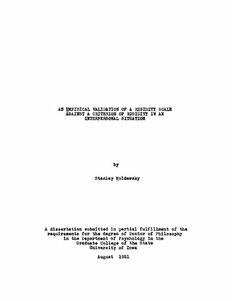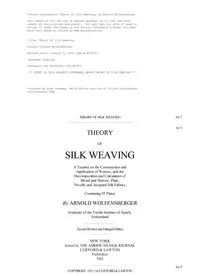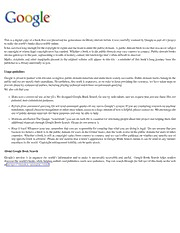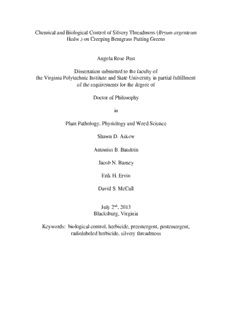
An empirical validation of a rigidity scale PDF
Preview An empirical validation of a rigidity scale
AN EMPIRICAL VALIDATION OF A BIGIDITY SCALE AGAINST A CBITEHION OF RIGXDITJ? IN AN XmBFSN&OMAL SITUATION toy Stanley Moldawsky A dissertation submitted in partial fulfillm ent of the requirements for the degree of Doctor of Philosophy in the Department of Psychology in the Graduate College of the State University of Iowa August 1951 ProQuest Number: 10598622 All rights reserved INFORMATION TO ALL USERS The quality of this reproduction is dependent upon the quality of the copy submitted. In the unlikely event that the author did not send a complete manuscript and there are missing pages, these will be noted. Also, if material had to be removed, a note will indicate the deletion. uest ProQuest 10598622 Published by ProQuest LLC (2017). Copyright of the Dissertation is held by the Author. All rights reserved. This work is protected against unauthorized copying under Title 17, United States Code Microform Edition © ProQuest LLC. ProQuest LLC. 789 East Eisenhower Parkway P.O. Box 1346 Ann Arbor, Ml 48106 - 1346 kQKmmmmmms The w riter wishes to express his sincere gratitude and appreciation to Dr. W. Or&nt Dahl* strom under whose direction th is investigation was undertaken. His generous donation of time and effo rt greatly fa c ilita te d conducting th is research. Many thanks are due Dr. Harold P. Bechtoldt fo r his aid in the sta tistic a l analy sis . Appreciation is extended to Dr. Irving Barnett fo r his s te lla r role*playing as the “reluctant buyer.n The w riter is grateful to Mrs. Leona Dahlstrom, Mr. Hod Kabriek, Mr. Mar tin Krakauer, Mrs. Margaret Lawrence, and Miss Alma Nicholas fo r th eir assistance as judges. The w riter is especially Indebted to his wife and colleague, Pat, for her continual aid and encouragement. ii TABLE OF COOTKOTS Page Introduction 1 Procedure .* 8 ResuIts .... 14 Discussion * 34 Summary .•.* 43 References * 49 Appendix A * 38 Appendix B * 63 Appendix C • 72 Appendix D - 75 Appendix E • 78 Appendix F * @2 Appendix G . 91 Appendix H • 98 Appendix I . 101 Appendix J *« 106 i l l TABLE OF TABLES Tabl^ Page X Analysis of Variance fo r Five Haters and 66 Subjecta and the R eliab ility C oeffl- elents Obtained from I t . . . . . . . . ............................ 16 XX R eliab ilities of Judges Ratings on Eight Subscores of Rating S c a le ........... . . . 13 XXI Means and standard deviations of the Four Groups on the ¥ford Fluency Tests in Terms of Standard Scores ..........* . . . ............... 19 XV Simple Analysis of Variance of the Dif ferences between Mew Verbal Fluency Scores of 66 Subjects (in Terms of Mor* mallaed standard Scores) ............. 20 V Intercorrelations of Mon-Experimental Variables (Sentence Fluency and Similes Testa) with Composite Ratings and R Scale ............... . . ................... 22 VX Means and Standard Deviations of Similes and Sentence Fluency Scores of Individ uals Scoring in Top or Bottom 20$ of R Scale 24 VII Means and Standard Deviations of Similes and Sentence Fluency Scores of Individu als Rated Rigid and Flexible in the Spontanelty Test ............. 26 VIII Means and Standard Deviations of Ratings of Individuals With and Without Previous Selling Experiences .................. 28 IX Chi Square Test of Independence of S ell ing Experience and R Scale . • • .................... 30 iv Table Page X Means and Standard Deviations of Com** posit© Bating© from Five Judges fo r Four Conditions ................................... 31 XX Analysis of Variance of the D ifference between Mean Bating© of R igidity In the Spontaneity Test ................................ ♦ 32 XII Analysis of Variance of the D ifference between Mean Ratings of (Subscore 7) A bility to Handle the "Surprise® in the Spontaneity Test «»*»**•**.*«*•»»,*,*.................... 33 X III Means and Standard Deviations of Scores on the "Hew R igidity Scale** fo r Rated Rigid, Rated F lexible, normal, and Cross- V alidation Croups ...................• .•••••*•«•• 104 XIV A nalysis of Variance of the D ifference between Mean Ratings of (Sub-score 1) "Bat© In Acceptance* in Spontaneity T e s t ■ ............................****♦...............107 XV A nalysis of Variance of the D ifference between Mean Eatings of (Sub-score 2} "Tries D ifferent Approaches® in Spon taneity Test »•*»»•»*.*.......... 108 XVI Analysis of Variance of the D ifference between Mean Ratings of (Sub-score 3) "D ifferent Verbal Expressions* In Spon taneity Teat .............. 109 XVII A nalysis of Variance of the D ifference between Mean Ratings of (Sub-score 4) "Perseveretea in Approaches" in Spon tan eity Test *.......................................................................110 v gfcto* Zsea XVX11 Analysis of Variance ©f the D ifference between Mean Ratings of (Sub-score 5) "Novelty in Approaches” in Spontaneity feet ............................................. I l l XIX Analysis of Variance of the D ifference between Mean Bating© of (Sub-score 6} "Appropriateness of Response11 In Spon tan eity feet ............................ *......... 113 XX A nalysis of Variance of the D ifference between Mean Ratings of (Sub-score 8) "Length of Time” in Spontaneity Test *»..**« 113 vi TABLE OP FIGURES Figure Page 1 Assignment of subjects to groups .................. 8 8 Frequency d istrib u tio n s of the four groups (Hated Rigid* Rated Flexible* iorm&l, and Cross-V alidation groups) on the "new rig id ity seals** ............ 108 1 Chapter I lOTRODUmOH Although rig id ity has been studied In many con texts In the analysis of human behavior there Is no unani mity In the fie ld as to its nature nor any consistency in Its use as a construct. Some of the follow ing formula tions have been advanced and I t can be observed that the concepts are quite heterogeneous* R igidity has been thought of as a general personality tr a it, a defense against anxiety, as an in te lle c tiv e a b ility , as due to co rtical pathology or simply as a perseveratlng response tendency. Ihe facto r analysts, notably Spearman and his students (29) have Isolated a perserveration facto r, (?), in tasks involving altern atio n of simple motor responses, altern atio n of creative e ffo rt or persistence in single a c tiv ity . Thurston© sim ilarly isolated a facto r (E), which he labelled a b ility to sh ift set* (53) Both of these are sim ilar however to the rig id ity concept u tilize d by C atto ll (6). Based on tasks involving altern atio n of creative e ffo rt, C a tte ll^ ’’D isposition R igidity" facto r is found in tasks demanding a new approach to an old 2 situation* Ha considers i t is a general personality char a c te ristic not necessarily related to intelligence# Thus facto r analysts conceive of rig id ity sometimes as an in te lle c tiv e a b ility and a t other times as a general person a lity trait* O oldstein (12) has conceptualized rig id ity pre dominantly in terms of neuropathology. But he emphasizes two kinds* primary rig id ity and secondary rig id ity * P ri mary rig id ity refers to H .••• sequelae of an abnorm ality of the E instellung mechanism, most frequently observed in lesions of the subcortical ganglia* Each performance in action immediately becomes so rig id th at responses to ex traneous stim uli cease* Secondary rig id ity is due to a primary defect of the higher mental processes occurring in co rtical damage and co rtical m alform ations, such as feeble mindedness* I t occurs only if the individual is confront ed w ith tasks beyond his cap ab ilities* ** (12, p. 223) 2his la tte r concept O oldstein admits may be true of normal peo ple also, th at is , they may exhibit rig id ity when In per formances beyond th e ir cap acities. ‘This conception is also developed by the fie ld th eo rists in discussing stereo typed behavior (14, 16, 20). Lack of v aria b ility and ad ap tab ility are behavioral indications of th is rigidity*
The list of books you might like

Mind Management, Not Time Management

Shatter Me Complete Collection (Shatter Me; Destroy Me; Unravel Me; Fracture Me; Ignite Me)

$100m Offers

The 48 Laws of Power

Objektorientierte Programmierung mit JavaScript: Direktstart für Einsteiger

Photography Second edition

What's Bred in the Bone by Grant Allen

Ungleichheit Warum wir nicht alle gleich viel haben müssen

By Cracky, Abe's Nominated

Bon Dia Aruba (21 Januari 2006)

Theory of Silk Weaving

Sanskritik Binimay Aru Sanhati

aquatic weeds in the sudan

The treaty of Miṣr in Ṭabari: an essay in criticism

HLA-DQ transgenic NOD models of autoimmunity

Ama-Porter

(Bryum argenteum Hedw.) on Creeping Bentgrass Putting Greens Angela Rose P

Ecología

Bertolt Brecht : Homme pour homme

personalsafety

Handbook of olfaction and gustation, Volume 236

Boston College magazine

CAHIER D'ACCOMPAGNEMENT DU COFFRET DE CD AMOUR TOXIQUE Diane Borgia

